
-
 Afrikaans
Afrikaans -
 Albanian
Albanian -
 Amharic
Amharic -
 Arabic
Arabic -
 Armenian
Armenian -
 Azerbaijani
Azerbaijani -
 Basque
Basque -
 Belarusian
Belarusian -
 Bengali
Bengali -
 Bosnian
Bosnian -
 Bulgarian
Bulgarian -
 Catalan
Catalan -
 Cebuano
Cebuano -
 China
China -
 China (Taiwan)
China (Taiwan) -
 Corsican
Corsican -
 Croatian
Croatian -
 Czech
Czech -
 Danish
Danish -
 Dutch
Dutch -
 English
English -
 Esperanto
Esperanto -
 Estonian
Estonian -
 Finnish
Finnish -
 French
French -
 Frisian
Frisian -
 Galician
Galician -
 Georgian
Georgian -
 German
German -
 Greek
Greek -
 Gujarati
Gujarati -
 Haitian Creole
Haitian Creole -
 hausa
hausa -
 hawaiian
hawaiian -
 Hebrew
Hebrew -
 Hindi
Hindi -
 Miao
Miao -
 Hungarian
Hungarian -
 Icelandic
Icelandic -
 igbo
igbo -
 Indonesian
Indonesian -
 irish
irish -
 Italian
Italian -
 Japanese
Japanese -
 Javanese
Javanese -
 Kannada
Kannada -
 kazakh
kazakh -
 Khmer
Khmer -
 Rwandese
Rwandese -
 Korean
Korean -
 Kurdish
Kurdish -
 Kyrgyz
Kyrgyz -
 Lao
Lao -
 Latin
Latin -
 Latvian
Latvian -
 Lithuanian
Lithuanian -
 Luxembourgish
Luxembourgish -
 Macedonian
Macedonian -
 Malgashi
Malgashi -
 Malay
Malay -
 Malayalam
Malayalam -
 Maltese
Maltese -
 Maori
Maori -
 Marathi
Marathi -
 Mongolian
Mongolian -
 Myanmar
Myanmar -
 Nepali
Nepali -
 Norwegian
Norwegian -
 Norwegian
Norwegian -
 Occitan
Occitan -
 Pashto
Pashto -
 Persian
Persian -
 Polish
Polish -
 Portuguese
Portuguese -
 Punjabi
Punjabi -
 Romanian
Romanian -
 Russian
Russian -
 Samoan
Samoan -
 Scottish Gaelic
Scottish Gaelic -
 Serbian
Serbian -
 Sesotho
Sesotho -
 Shona
Shona -
 Sindhi
Sindhi -
 Sinhala
Sinhala -
 Slovak
Slovak -
 Slovenian
Slovenian -
 Somali
Somali -
 Spanish
Spanish -
 Sundanese
Sundanese -
 Swahili
Swahili -
 Swedish
Swedish -
 Tagalog
Tagalog -
 Tajik
Tajik -
 Tamil
Tamil -
 Tatar
Tatar -
 Telugu
Telugu -
 Thai
Thai -
 Turkish
Turkish -
 Turkmen
Turkmen -
 Ukrainian
Ukrainian -
 Urdu
Urdu -
 Uighur
Uighur -
 Uzbek
Uzbek -
 Vietnamese
Vietnamese -
 Welsh
Welsh -
 Bantu
Bantu -
 Yiddish
Yiddish -
 Yoruba
Yoruba -
 Zulu
Zulu
Fiberglass 90 Degree Elbow for Custom Tanks & High Pressure Pipes Durable and Corrosion Resistant
- Introduction to Fiberglass 90 Degree Elbow: Functionality and Importance
- Technical Advantages of Fiberglass Components Over Traditional Materials
- Comparing Leading Manufacturers: Quality, Performance, and Innovation
- Customization: Flexible Solutions with Custom Fiberglass Tanks and Elbow Fittings
- Performance Analysis: High Pressure Fiberglass Pipe Applications
- Real-World Application Cases
- Conclusion: The Value of Fiberglass 90 Degree Elbow in Modern Industry

(fiberglass 90 degree elbow)
Introduction to Fiberglass 90 Degree Elbow: Functionality and Importance
The fiberglass 90 degree elbow
is a crucial component in various piping systems across multiple industries. Its primary function is to alter the direction of flow in pipelines, typically by 90 degrees, ensuring an efficient layout and optimal use of space. Engineered with reinforced fiberglass, this elbow fitting stands out for its ability to handle corrosive environments, high temperatures, and varying pressures. Compared to metal counterparts, fiberglass elbows are significantly lighter, which reduces installation time and labor costs. The proliferation of custom fiberglass tanks and the increasing demand for high pressure fiberglass pipe applications in chemical processing, water treatment, and oil & gas sectors have further highlighted the value of these elbows. Market studies show that the global demand for composite piping—including fiberglass components—grows at an average rate of 5.8% annually, underlining their accelerating acceptance for critical infrastructure.
Technical Advantages of Fiberglass Components Over Traditional Materials
Fiberglass piping systems, particularly the 90 degree elbows, present a series of advantages over traditional materials such as carbon steel or PVC. Fiberglass demonstrates excellent chemical resistance, mitigating the risk of corrosion—a frequent challenge when transporting aggressive media. The inherent non-conductive nature of fiberglass enhances safety in electrically sensitive applications. Additionally, the smooth internal surface finish promotes superior hydraulic efficiency, reducing frictional losses by up to 20% when compared with rougher surfaces in steel pipes. Fiberglass weighs approximately one-quarter of steel, with a tensile strength that can reach 280 MPa, enabling easier handling without compromising on structural integrity. Maintenance frequency is also drastically reduced; data from maintenance logs of large water treatment plants indicate a reduction of 40% in annual maintenance hours when switching from metal to fiberglass piping, translating into significant operational cost savings.
Comparing Leading Manufacturers: Quality, Performance, and Innovation
Selecting the right supplier is critical for ensuring the reliability and performance of fiberglass 90 degree elbows and related products. The global market is served by several top-tier manufacturers, each offering unique advantages. Key criteria for comparison include pressure rating, customization capabilities, certification, and membrane thickness. Below is a data table that highlights distinguishing features among leading brands:
| Feature | Brand A | Brand B | Brand C |
|---|---|---|---|
| Max Pressure (psi) | 350 | 300 | 275 |
| Temperature Range (°F) | -40 to 220 | -30 to 210 | -20 to 200 |
| Custom Tank Integration | Yes | Yes | No |
| Industry Certifications | ISO 9001, ASTM D2996 | ISO 9001 | ASTM D2996 |
| Wall Thickness (mm) | 6 | 5.2 | 4.8 |
| Average Lead Time (days) | 18 | 25 | 15 |
The data clearly showcases Brand A as a leader in both pressure range and integration flexibility, making it suitable for demanding environments where custom fiberglass tanks and high pressure fiberglass pipe configurations are necessary.
Customization: Flexible Solutions with Custom Fiberglass Tanks and Elbow Fittings
Modern industrial facilities require adaptable piping systems that cater to unique operational challenges. The ability to customize both the fiberglass 90 degree elbow and custom fiberglass tanks is critical to maximizing efficiency and performance. Advanced manufacturers offer extensive customization, including diameter variation ranging from as small as 1 inch to over 60 inches, wall thickness adjustments for pressure optimization, and specialized resins for enhanced chemical compatibility. For example, epoxy vinyl ester resins are often selected for environments involving high concentrations of acids, extending service life by 30% compared to standard polyester resin options. Additionally, collaboration with design engineers enables the integration of elbows directly into tank systems, reducing both space and installation requirements. Using 3D modeling and finite element analysis, many suppliers can simulate operational stresses in advance, ensuring that each custom solution meets stringent international standards and customer-specific requirements.
Performance Analysis: High Pressure Fiberglass Pipe Applications
The application of high pressure fiberglass pipe systems, including the essential 90 degree elbow fittings, spans sectors such as desalination, petrochemical, and municipal water networks. In high-pressure pipelines, system reliability is crucial; a single failure can result in operational downtime and environmental hazards. Real-world data reveals that these fiberglass systems can withstand cyclic pressures up to 350 psi over 10,000 cycles without measurable degradation. This performance surpasses many metallic alternatives, wherein pitting and stress corrosion often cause premature failures. Recent field tests in oilfield injection lines demonstrate a 12-year mean time between failures (MTBF) for fiberglass versus just 5 to 8 years for steel systems operating under comparable pressure and fluid composition. Furthermore, the lightweight nature of these systems reduces transportation costs by more than 60%, making them highly attractive for remote installations with limited access to heavy-lifting equipment.
Real-World Application Cases
Several high-profile projects highlight the effective use of fiberglass elbows and related piping solutions. In 2022, a leading chemical processing company retrofitted its cooling water network with fiberglass piping, including over 500 units of 90 degree elbows. Over the first year of operation, routine inspections recorded a reduction of 90% in biofouling and scale formation compared to the previous metallic system. Another key application is in municipal desalination plants: a facility in Southern California integrated custom fiberglass tanks and elbows, enabling it to increase capacity by 35% while reducing maintenance labor by 25%. In the energy sector, an oil and gas operator utilized high pressure fiberglass pipe assemblies on offshore platforms. The project reported a weight reduction of 70 tons compared to the previous steel design, directly lowering fuel consumption for platform supply vessels and contributing to a 12% reduction in the operation's carbon footprint.
Conclusion: The Value of Fiberglass 90 Degree Elbow in Modern Industry
The fiberglass 90 degree elbow has emerged as a pivotal component for modern industrial piping systems, from chemical processing and water treatment to energy production. Supported by its data-backed advantages—including superior corrosion resistance, lightweight construction, and outstanding adaptability—these fittings are reshaping piping design paradigms. The synergy between custom fiberglass tanks and high pressure fiberglass pipe configurations allows for tailored solutions that meet complex operational requirements, reducing both lifetime maintenance and environmental impact. As industries continue to prioritize efficiency, resilience, and sustainability, the integration of fiberglass components such as the 90 degree elbow will remain central to achieving long-term operational excellence and cost savings.

(fiberglass 90 degree elbow)
FAQS on fiberglass 90 degree elbow
Q: What is a fiberglass 90 degree elbow used for?
A: A fiberglass 90 degree elbow is designed to change the direction of flow in piping systems. It is commonly used in water, chemical, and industrial applications for corrosion resistance. These elbows ensure smooth fluid transfer between pipes set at a right angle.Q: Can fiberglass 90 degree elbows be used with high pressure fiberglass pipes?
A: Yes, fiberglass 90 degree elbows are compatible with high pressure fiberglass pipes. They are manufactured to withstand significant internal pressures while maintaining structural integrity. Always check the specific pressure rating for your application.Q: Are fiberglass 90 degree elbows suitable for custom fiberglass tanks?
A: Yes, fiberglass 90 degree elbows can be integrated into custom fiberglass tank designs. They help facilitate inlet/outlet connections and optimize flow management. Proper installation ensures leak-free performance in tank applications.Q: What are the advantages of using fiberglass 90 degree elbows over metal elbows?
A: Fiberglass elbows offer superior corrosion resistance and are lightweight compared to metal alternatives. They require less maintenance and are suitable for aggressive environments. This makes them cost-effective in the long run.Q: Can I order fiberglass 90 degree elbows in custom sizes for my project?
A: Many manufacturers provide fiberglass 90 degree elbows in custom sizes and specifications. Customization ensures a perfect fit for unique piping systems or custom fiberglass tanks. Contact your supplier with your project requirements for available options.Latest news
-
Fiberglass 90 Degree Elbow for Custom Tanks & High Pressure Pipes Durable and Corrosion ResistantNewsJun.24,2025
-
Exploring the Benefits of Top Hammer Drifter Rods for Enhanced Drilling PerformanceNewsJun.10,2025
-
High-Precision Fiberglass Winding Machine for GRP/FRP Pipe Production – Reliable & Efficient SolutionsNewsJun.10,2025
-
FRP Pipes & Fittings for Shipbuilding - Corrosion-Resistant & LightweightNewsJun.09,2025
-
Premium FRP Flooring Solutions Durable & Slip-ResistantNewsJun.09,2025
-
Premium Fiberglass Rectangular Tanks Durable & Lightweight SolutionNewsJun.09,2025









